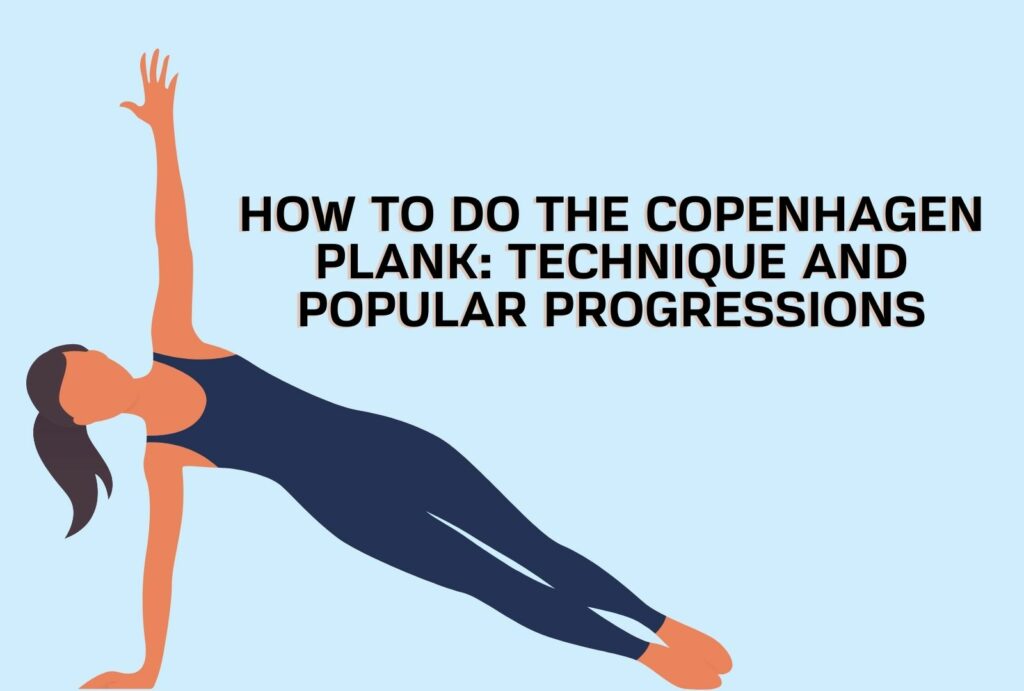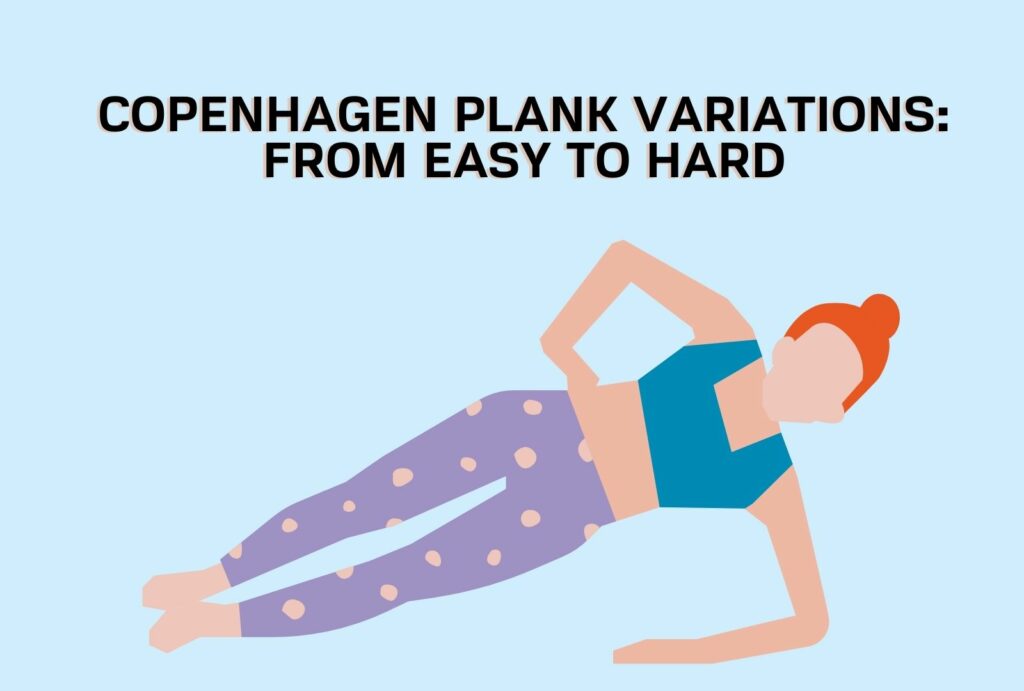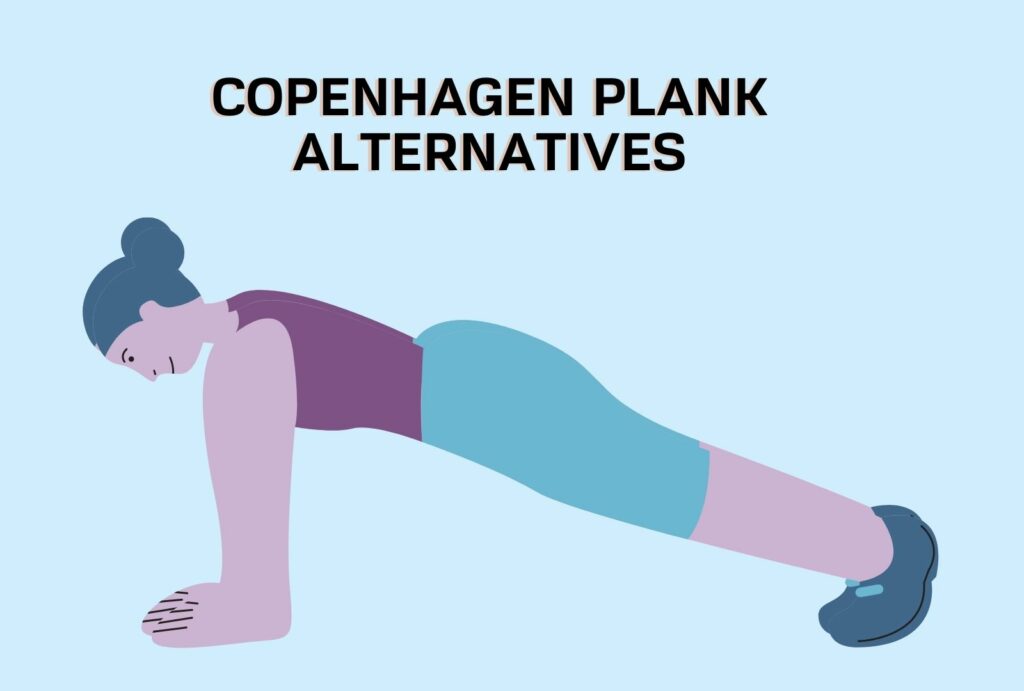
The Copenhagen plank is a challenging and effective exercise that targets the oblique muscles, helping to strengthen the core and improve overall body stability. Named after the city in Denmark where it was popularized, the copenhagen plank has gained popularity in the fitness world for its ability to activate and work the internal and external obliques simultaneously.
To perform the copenhagen plank, you will need a stable surface, such as a bench or a box, that is high enough to place your feet on. Begin by lying on your side with your feet resting on the surface and your body forming a straight line from head to heels. Place your forearm on the ground and lift your hips off the ground, holding the position for a set amount of time before switching sides.
The copenhagen plank
One popular progression of the copenhagen plank is to add a weight to the exercise. This can be done by holding a weight plate or dumbbell on your top hip during the exercise. This additional weight challenges your core muscles and helps to increase the difficulty of the exercise.
“Marching” copenhagen plank
Another popular progression is the “marching” copenhagen plank, where you lift one foot off the surface and hold it in the air for a set amount of time before switching sides. This adds an extra level of difficulty to the exercise, as your core muscles work harder to maintain stability and balance.
When performing the copenhagen plank, it is important to keep your core muscles engaged and your body in a straight line from head to heels. Focus on breathing deeply and maintaining proper form throughout the exercise. It is also important to start with a shorter hold time and work your way up to longer holds as you build strength and endurance.
In conclusion, the copenhagen plank is a challenging exercise that can help to improve core strength and stability. By adding weight or trying different progressions, you can continue to challenge your muscles and achieve even greater results. Incorporating the copenhagen plank into your fitness routine can help you to build a stronger, more stable core and improve your overall fitness and health.
Muscles Copenhagen plank works
The copenhagen plank is a highly effective exercise that targets multiple muscles in the body, specifically the obliques, rectus abdominis, and transverse abdominis. This exercise is known for its ability to activate and strengthen the core muscles, making it a popular choice for athletes, fitness enthusiasts, and anyone looking to improve their overall fitness level.
The obliques
The primary muscle group targeted during the copenhagen plank is the obliques. The obliques are the muscles located on the sides of the abdominals and are responsible for rotating and flexing the trunk. By performing the copenhagen plank, you are activating and strengthening the internal and external obliques, which can help to improve your overall core strength and stability.
The rectus abdominis
In addition to the obliques, the copenhagen plank also targets the rectus abdominis. This muscle group, commonly known as the “six-pack,” is located in the front of the body and is responsible for flexing the spine. By engaging the rectus abdominis during the copenhagen plank, you are working to strengthen and tone this muscle group, helping to improve your overall core strength and definition.
The transverse abdominis
Another muscle group targeted during the copenhagen plank is the transverse abdominis. This deep abdominal muscle is responsible for stabilizing the spine and pelvis, making it an essential muscle for overall core stability. By performing the copenhagen plank, you are activating and strengthening the transverse abdominis, helping to improve your posture, balance, and overall stability.
While the copenhagen plank primarily targets the core muscles, it also engages and strengthens the muscles in the hips, glutes, and legs. By placing your feet on a stable surface and lifting your hips off the ground, you are working to engage and activate the muscles in the lower body, helping to improve your overall lower body strength and stability.
In conclusion, the copenhagen plank is a highly effective exercise that targets multiple muscle groups in the body. By incorporating this exercise into your fitness routine, you can improve your overall core strength, stability, and definition, as well as work to strengthen the muscles in your lower body. Whether you are an athlete or just looking to improve your overall fitness level, the copenhagen plank is a great exercise to add to your workout routine.
Copenhagen side plank: technique, tips, and progressions
The Copenhagen side plank is a challenging exercise that targets the obliques, hips, and glutes. This exercise is similar to the traditional side plank but is performed with one leg raised and the foot resting on a bench or box, making it a more advanced variation of the copenhagen plank.
The copenhagen side plank
Technique
To perform the copenhagen side plank, start by lying on your side with your forearm on the ground and your feet stacked on top of each other. Lift your hips off the ground, keeping your body in a straight line from head to heels. Then, lift your top leg and place your foot on a bench or box, creating a 90-degree angle with your knee. Hold the position for a set amount of time before switching sides.
One important tip for performing the copenhagen side plank is to focus on keeping your core engaged and your body in a straight line from head to heels. It can be helpful to look at your form in a mirror or have a trainer or workout buddy check your form to ensure you are performing the exercise correctly.
A popular progression of the copenhagen side plank is to add a weight to the exercise. This can be done by holding a weight plate or dumbbell on your top hip during the exercise. This additional weight challenges your core muscles and helps to increase the difficulty of the exercise.
“Pulsing”
Another popular progression is to add a “pulsing” movement to the exercise. This involves lifting your top leg up and down in a controlled motion, while maintaining the copenhagen side plank position. This extra movement adds an extra level of difficulty to the exercise, challenging your core muscles and helping to increase your overall strength and stability.
In conclusion, the copenhagen side plank is a challenging exercise that targets the obliques, hips, and glutes. By adding weight or trying different progressions, you can continue to challenge your muscles and achieve even greater results. Incorporating the copenhagen side plank into your fitness routine can help you to build a stronger, more stable core and improve your overall fitness and health. Remember to focus on proper form and engage your core muscles throughout the exercise to get the most out of this challenging movement.
Copenhagen plank variations: from easy to hard

The copenhagen plank is a versatile exercise that can be adapted to suit different fitness levels and goals. By modifying the position of the feet, adding weights or resistance, or incorporating other movements, the copenhagen plank can be made easier or more challenging. In this article, we will explore some copenhagen plank variations, from easy to hard.
Basic copenhagen plank
The easiest copenhagen plank variation is the basic copenhagen plank.
Technique
To perform this exercise, lie on your back with your knees bent and feet flat on the ground. Lift your hips off the ground, keeping your body in a straight line from head to heels. Hold the position for a set amount of time, focusing on engaging your core muscles and maintaining proper form.
Side plank
Another variation of the copenhagen plank is the side plank. This exercise is similar to the copenhagen plank, but is performed on your side, with your forearm on the ground and your feet stacked on top of each other.
Technique
Lift your hips off the ground, keeping your body in a straight line from head to heels. Hold the position for a set amount of time before switching sides.
Copenhagen side plank
A more challenging copenhagen plank variation is the copenhagen side plank. This exercise is similar to the side plank, but is performed with one leg raised and the foot resting on a bench or box. This added height makes the exercise more challenging, as it requires more stability and control in the core muscles.
Technique
For an even more challenging copenhagen plank variation, try adding a weight to the exercise. This can be done by holding a weight plate or dumbbell on your top hip during the exercise. This additional weight challenges your core muscles and helps to increase the difficulty of the exercise.
“Pulsing” copenhagen plank
Technique
Another challenging copenhagen plank variation is the “pulsing” copenhagen plank. This involves lifting your hips up and down in a controlled motion, while maintaining the copenhagen plank position. This extra movement adds an extra level of difficulty to the exercise, challenging your core muscles and helping to increase your overall strength and stability.
In conclusion, the copenhagen plank is a highly effective exercise that can be adapted to suit different fitness levels and goals. By trying different variations of the exercise, you can challenge your muscles in new ways and continue to improve your overall fitness and health. Remember to focus on proper form and engage your core muscles throughout the exercise to get the most out of each variation.
Copenhagen plank alternatives

If you’re looking for an alternative to the copenhagen plank or simply want to mix up your core workout, there are several exercises that can be incorporated into your routine. While the copenhagen plank is a highly effective exercise, it’s always good to switch things up to avoid hitting a plateau or overworking the same muscle groups.
Standard plank
One alternative to the copenhagen plank is the standard plank. This exercise targets the same muscles as the copenhagen plank, but is a bit easier to perform.
Technique
To perform the plank, get into a push-up position with your forearms on the ground and your body in a straight line from head to heels. Hold the position for a set amount of time, focusing on engaging your core muscles and maintaining proper form.
Side plank
Another alternative to the copenhagen plank is the side plank. This exercise targets the obliques, hips, and glutes, just like the copenhagen plank.
Technique
To perform the side plank, lie on your side with your forearm on the ground and your feet stacked on top of each other. Lift your hips off the ground, keeping your body in a straight line from head to heels. Hold the position for a set amount of time before switching sides.
Leg raise
A more challenging alternative to the copenhagen plank is the hanging leg raise. This exercise targets the lower abs, hip flexors, and obliques.
Technique
To perform the hanging leg raise, hang from a pull-up bar with your legs straight. Keeping your core tight, raise your legs up as high as you can, then lower them back down to the starting position.
Turkish get-up
For an even more challenging alternative to the copenhagen plank, try the Turkish get-up. This full-body exercise targets the core, glutes, shoulders, and hips.
Technique
To perform the Turkish get-up, lie on your back with a weight held in one hand. From there, use a series of movements to stand up while keeping the weight held overhead.
Russian twist
Another great alternative to the copenhagen plank is the Russian twist. This exercise targets the obliques, as well as the rectus abdominis.
Technique
To perform the Russian twist, sit on the ground with your knees bent and feet flat on the ground. Lean back slightly, then rotate your torso to one side, tapping the ground with your hand. Rotate to the other side and repeat the movement.
In conclusion, the copenhagen plank is a highly effective exercise for building core strength and stability, but there are several alternatives that can be incorporated into your workout routine. By mixing up your exercises, you can challenge your muscles in new ways and continue to improve your overall fitness and health. Remember to focus on proper form and engage your core muscles throughout each exercise to get the most out of your workout.
Final words
In conclusion, the copenhagen plank is a challenging yet effective exercise that targets the obliques, hips, and glutes. By performing this exercise regularly, you can improve your core strength and stability, as well as enhance your overall fitness and health. It’s important to remember that proper form and technique are crucial when performing the copenhagen plank to avoid injury and get the most out of the exercise.
If you’re new to the copenhagen plank, start with the basic variation and gradually progress to more challenging variations as you build strength and endurance. Always listen to your body and take breaks when needed to prevent overworking your muscles. It’s also a good idea to incorporate other core exercises into your routine to avoid hitting a plateau and keep your workouts interesting.
Remember that the copenhagen plank is just one exercise in a comprehensive fitness program. To achieve optimal results, it’s important to maintain a balanced diet, get enough rest, and incorporate other types of exercise, such as strength training and cardio, into your routine. By taking a holistic approach to your fitness and health, you can achieve your goals and lead a happier, healthier life.
Whether you’re a seasoned fitness enthusiast or just starting out on your fitness journey, the copenhagen plank is a great exercise to incorporate into your routine. With its many variations and benefits, the copenhagen plank can help you build a strong, stable core and enhance your overall fitness and health. So don’t be afraid to give it a try and see the results for yourself!